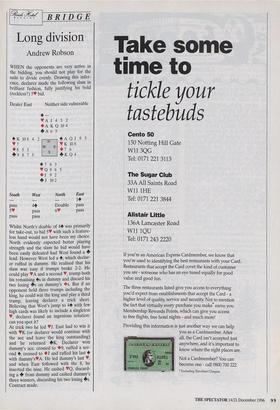BRIDGE
Long division
Andrew Robson
WHEN the opponents are very active in the bidding, you should not play for the suits to divide evenly. Drawing this infer- ence, declarer made the following slam in brilliant fashion, fully justifying his bold (reckless?) 5V bid.
Dealer East Neither side vulnerable South West North East 14 pass 44 Double pass 5V pass pass pass 6V pass Whilst North's double of 44 was primarily for take-out, to bid 5V with such a feature- less hand would not have been my choice. North evidently expected better playing strength and the slam he bid would have been easily defeated had West found a + lead. However West led a 4, which declar- er ruffed in dummy. He realised that his slam was easy if trumps broke 2-2. He could play VA and a second V, trump both his remaining 4s in dummy and discard his two losing 4s on dununy's *s. But if an opponent held three trumps including the king, he could win the king and play a third trump, leaving declarer a trick short. Believing that West's jump to 4* with few high cards was likely to include a singleton V, declarer found an ingenious solution: can you spot it? At trick two he led VJ. East had to win it with VK (or declarer would continue with the ace and leave the king outstanding) and he returned 4K. Declarer won dummy's ace, crossed to •9, ruffed a sec- ond 4, crossed to •J and ruffed his last 4 with dummy'sVA. He led dummy's last V, and when East followed with the 8, he inserted the nine. He cashed VQ, discard- ing a 4 from dummy and cashed dummy's three winners, discarding his two losing +s. Contract made.


















































































































 Previous page
Previous page